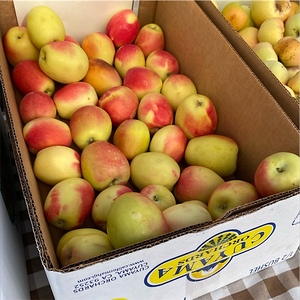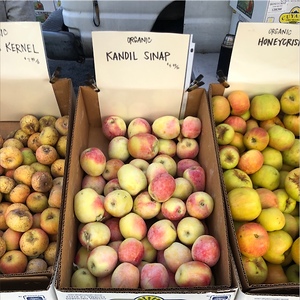


Kandil Sinap Apples
Estimated Inventory, lb : 0
Description/Taste
Kandil Sinap apples have a distinct elongated and narrow appearance with a tall, cylindrical, and somewhat uniform shape, connected to slender, dark brown stems. The skin is smooth, waxy, glossy, and yellow-green, developing a dark red blush with maturity and increased sun exposure. Underneath the thin skin, the flesh is crisp, fine-grained, aqueous, and cream-colored with light green veining, encasing a central fibrous core filled with a few black-brown, oval seeds. Kandil Sinap apples have a sugar-like aroma and a juicy, chewy, and crunchy consistency with a balanced sweet and acidic flavor.
Seasons/Availability
Kandil Sinap apples are harvested in the late fall and can be stored through early spring.
Current Facts
Kandil Sinap apples, botanically classified as Malus domestica, are a uniquely shaped, heirloom variety that belongs to the Rosaceae family. This late-season cultivar belongs to a larger group generally known as sinap apples, and many different varieties within this group are popularly cultivated in colder regions throughout Asia and eastern Europe. In Asia, Kandil Sinap apples are known more specifically as the Almaty Kandil Sinap, but they are also known by many different names around the world, including Candil and Candil Sinap, with sinap sometimes being spelled sinop. Kandil Sinap is named after the Sinop Peninsula on the Black Sea, and the word Kandil translates to mean lamp, symbolizing the bright and luminous appearance of the apple’s skin. Kandil Sinap apples are cultivated on a small scale and are considered a specialty dessert variety, primarily consumed fresh, out-of-hand. They are also popularly displayed as decorations, carefully stacked in bowls and on plates in kitchens to draw attention to their unusual shape.
Nutritional Value
Kandil Sinap apples are a good source of vitamin C, which is an antioxidant that can help protect the immune system and contain fiber, which can help stimulate the digestive tract. The fruits also contain some vitamin A, calcium, iron, and potassium.
Applications
Kandil Sinap apples are best suited for raw applications as their crisp, sweet, and acidic flesh are showcased when consumed fresh, out-of-hand. The apples can be sliced and served as a snack with dips, sliced and tossed into green salads, chopped into fruit salads, sliced over ice cream, or pressed into juices and ciders. Kandil Sinap apples can also be utilized in cooked applications such as making jams, jellies, butter, and sauces, or they can be baked into pies, tarts, muffins, bread, and cobblers. Kandil Sinap apples pair well with meats such as pork, beef, and poultry, cinnamon, nutmeg, lemon, vanilla, mint, pears, plums, and cranberries. The fresh apples will keep up to four months when stored in the refrigerator.
Ethnic/Cultural Info
In the 18th century, Kandil Sinap apples were once one of the most prized varieties in Crimean gardens and were highly exported into Moscow and St. Petersburg in Russia. The fruits were favored for their unique shape and exceptional flavor, and Crimean families would heavily guard their cultivation secrets, only passing the knowledge on to future generations to continue production. Kandil Sinap apples were so revered for their flavor that many regarded them as valuable as gold. Though the apples were one of the most popular varieties during the 18th century, the cultivar quickly faded from the markets due to a combination of Crimean deportation into central Asia, post-war fruit tree taxes, and newer, modern fast-growing European varieties replacing the slow-growing Kandil Sinap.
Geography/History
Kandil Sinap apples were believed to have been created from a natural mutation before the 18th century, but the exact history is unknown as two centers of origin have been heavily debated. One theory is the variety came from Turkey, while the other theory points to Crimea, now modern-day Ukraine, with both locations bordering the Black Sea. Regardless of the variety’s exact origins, the apples were heavily cultivated by Crimean Tatars, who began exporting the apples into Russia in the 18th century. Today Kandil Sinap apples are produced on a small scale for local markets in Asia and Europe.












